Metric Dough Formulation Made Easy (Sort of)
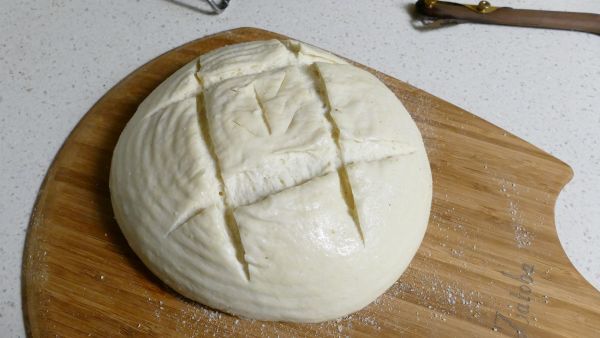

Here in the USA, we are still scared of metric when it comes to weighing ingredients for baking (and scared of metric for everything else too!). I was in that boat ten years ago. I finally purchased a “standard” (pounds, ounces) kitchen scale and began measuring by weight instead of using volume measurements (cups, tablespoons etc).
Well that still wasn’t enough because most of the bakers around the world use metric not standard for weighing measurements. Constantly having to convert from one to the other didn’t always work too well plus it’s extra effort. If you want to be part of the worldwide community of bakers, you need to use metric for weighing.
For instance if the formula states 19 grams of salt is needed, most basic standard kitchen scales start at 1 ounce, now what do I do? There are approximately 28 grams to one ounce. If you end up just adding one ounce of salt to your dough instead of 19 grams… no one will eat your bread!
Make Your Own Dough Formula
Getting Started with Flour and Water
Eventually I jumped off the cliff and set my kitchen scale to metric and I’ve never turned back (unless I need to convert or even sometimes when measuring very tiny amounts of spices etc).
It took me a while, just like learning a new language, and I still don’t always understand everything, but now I “think” in grams, kilograms etc and not ounces, pounds, cups, teaspoons etc. Metric is WAY easier to formulate with.
Take for instance:
1000 grams of flour (1 kilogram).
All of your ingredient weights will be a percentage based off of the flour weight (baker’s do it this way, it’s called Baker’s Percent). Don’t get flustered, just keep reading…
Now you want to add some water to the dough, how much do you add? Well if you use the 1000 grams of flour in your formula to begin with, it’s easy!
If you add 500 grams of water, you will have very stiff dough (like for bagels). If you add 650 grams of water you have a medium stiff dough. Add 700 grams of water and you have a nice, slightly sticky wettish dough. Add even more, like 800 – 900 grams (or more) and you are working with some really wet fluid dough.
Let’s now take a look at that:
- 1000 grams of flour (white bread flour)
- 700 grams water
Since percentage is always based off of 100, let’s just knock off the end zeros:
- 100 grams flour
- 70 grams water
So for every 100 grams of flour you use, add 70 grams of water and you will have dough at 70% hydration. Because hydration means how much water is in the dough by percentage weight, it is easy to figure out what hydration of dough you want just by using metric and starting out with a kilogram (1000 grams) of flour.
Examples:
- 1000 grams of flour and 800 grams of water = 80% hydration dough
- 1000 grams of flour and 620 grams of water = 62% hydration dough
- 1000 grams of flour and 740 grams of water = 74% hydration dough
If 1000 grams or 1 kilo of flour is too much for you to start with then just halve the amount and then also halve the amount of water:
- 500 grams of flour and 400 grams of water still = 80% hydration dough
- 500 grams of flour and 310 grams of water still = 62% hydration dough
- 500 grams of flour and 370 grams of water still = 74% hydration dough
You see what I mean? You can cut it down further if you like by using only a quarter of the flour and a quarter of the water or by multiplying the original amount by 0.25, like this 1000 x 0.25= 250 (grams of flour).
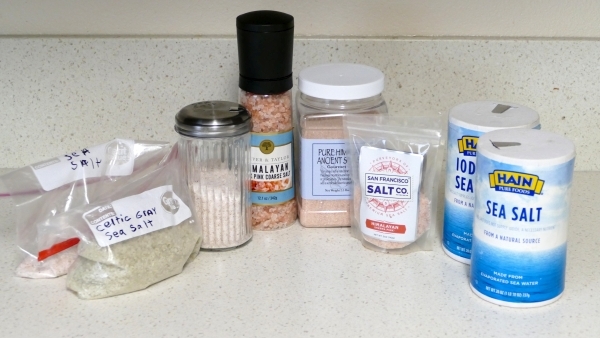
Salt
Let’s go onto our third main ingredient, salt. Salt is standard at 2% of flour weight. When you know this, you won’t add too much salt to your dough (which can make it inedible!).
If you start again with 1000 grams of flour, 2% = 20 grams (remember just knock off a zero from each weight to get your percent 1000 and 20%. So for every 100 grams of flour you would use 2 grams of salt. When you start with 1000 grams of flour you need 20 grams of salt. If you want to halve the amount, just do it: 500 grams of flour and 10 grams of salt. It’s still at 2% salt weight for flour weight.
If you like your bread a little less salty, that’s easy too. Using 1000 grams of flour again as your base weight to figure your other ingredient percentages by, 1.8% = 18 grams of salt, 1.5% = 15 grams of salt.
So let’s put that altogether and make up a bread dough formula:
- 1000 grams of bread flour
- 680 grams of water
- 20 grams of salt
This formula will give you 1700 grams of dough at 68% hydration. This is your baseline dough.
What About Leavening?
Now you need to think about your leaven. Will you be using a chemical leaven (like for a batter)? Will you use dry or wet commercial yeast? Will you be using a sourdough starter?
Chemical leavings used for baking are usually baking soda and baking power. They will not affect the hydration of the batter/dough but you need such a small amount of them (for the home baker) that for small batches it can be easier to use a 1/4, 1/2 or 1 teaspoon measure (also with small amounts of spices). For large amounts of dough, using grams is still easiest.
For commercial dry and wet yeast you would proof the yeast first using a small amount of the water from the formula. This will not change the hydration of the dough. Dried yeast is used at around 1% of flour weight.
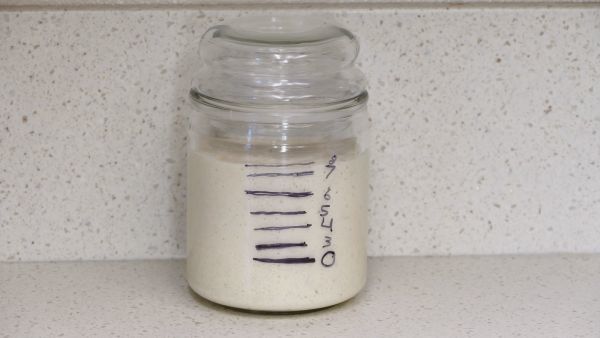
For a sourdough starter it is different though. Most sourdough starters are kept at 100% hydration on purpose by bakers so that it is easy to determine the amount of flour and water in the starter. A 100% starter, of course, has the same WEIGHT of water and flour. 100 grams of sourdough starter has 50 grams of water and 50 grams of flour in it.
Here comes the tricky part. Formulas contain all different amounts of starter in them. There is no set amount. The amount of starter you would use depends upon your method (the amount of starter can be called the inoculation amount). If you want a slow warm ferment, you will need less starter. If you want a long cool ferment, you might want more starter in your dough. If you want a one day short room temperature ferment you might inoculate your dough with more starter. To speed up dough you add more starter and/or use warmer temperatures. To slow down dough, you would add less starter and/or use cooler temperatures.
Even though I said there is no standard amount of sourdough starter used in a dough, there is an amount that will give you a starting place. If you start out with 20-30% starter (by total flour weight of the formula) you will have a nice active dough that you can bulk ferment and bake in one day.
Let’s Figure it Out.
So let’s take our formula and add some sourdough starter to it:
- 1000 grams of bread flour
- 680 grams of water
- 20 grams of salt
- 200 grams of sourdough starter at 100% hydration (which will be 100 grams of water an 100 grams of flour.
Now we need to add the flour from the starter to the total amount of flour in the dough: 1000 grams flour + 100 grams of flour in the starter = 1100 grams of total flour in the formula.
Let’s do the same with the water: 680 grams of water from the formula + 100 grams of water from the starter = 680+100 = 780 grams total water in your formula. So now we have a total: 1100 grams of flour and 780 grams of water in the formula. Divide the water by the flour: 780/1100 and you have: 0.709 which rounds off to 71% hydration. By adding the starter, your dough is now wetter at 71% hydration.
Once you add a sourdough starter to a base formula, the formula changes in hydration. We still have the original formula but we’ve added extra flour and water from the sourdough starter:
- 1000 grams bread flour
- 680 grams water
- 20 grams salt
- 200 grams sourdough starter at 100% hydration
Now there is 1900 grams (or 1.9 kilograms) of dough at 71% hydration.
You can add other (not wet) ingredients and the hydration will stay the same. You can add some sugar, raisins, seeds, herbs, dry milk powder etc. The dough weight will increase, but the hydration of the dough will be the same.
If you add syrups, wet milk, eggs or other ingredients that contain water, the dough hydration will change and your dough will become more slack/wetter.
If you add fats, the hydration (amount of water) won’t change but fats will act on the dough as if the hydration has changed and make the dough feel more slack/wet. Some bakers add in liquid fats as part of their hydration calculation, some do not.
Note
Some bakers will not figure the hydration amount of their starter into the dough, but treat the starter as an additional ingredient. So using the same formula as I have above, they may state that the dough is at 68% hydration (like the first formula above). Which technically isn’t true, but it makes it easier for baker’s who make up large amounts of dough to figure the starter as an additional ingredient instead of as part of the hydration of the dough.
They might do this:
- 1000 grams of flour (100% of flour weight)
- 680 grams of water (68% of flour weight)
- 20 grams salt (2% of flour weight)
- 200 grams of (100% hydration) sourdough starter (20% of flour weight)
They might say they have 1900 grams of dough at 68%. And that’s okay, it’s the way they figure it and they know what the dough is supposed to feel like.
In Conclusion
This is just a base formula to start with. The next step is the most important part and where the “artisan” element comes in. Will you do an autolyse (rest the dough before adding the salt), will you bulk ferment 2 hours, 4 hours (or more) what temperature do you want the dough at? Will you retard the dough (chill it) will you do a double hydration (add more liquid after an initial rest)? How will you shape it? How will you score it? Will you use a crust glaze? How will you bake it?
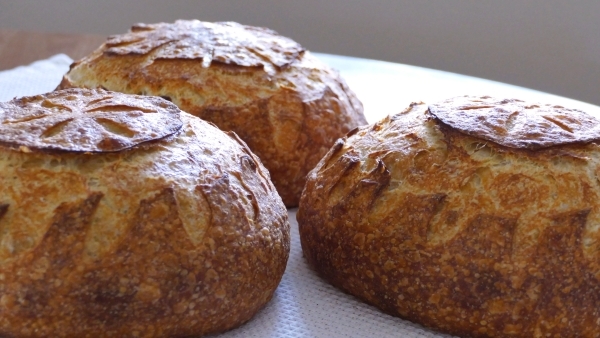
See HERE for a formula and method for baking a loaf of sourdough bread.
Click HERE if you need to find out how to make your own sourdough starter.
For more baking fun register for membership at The Baking Network

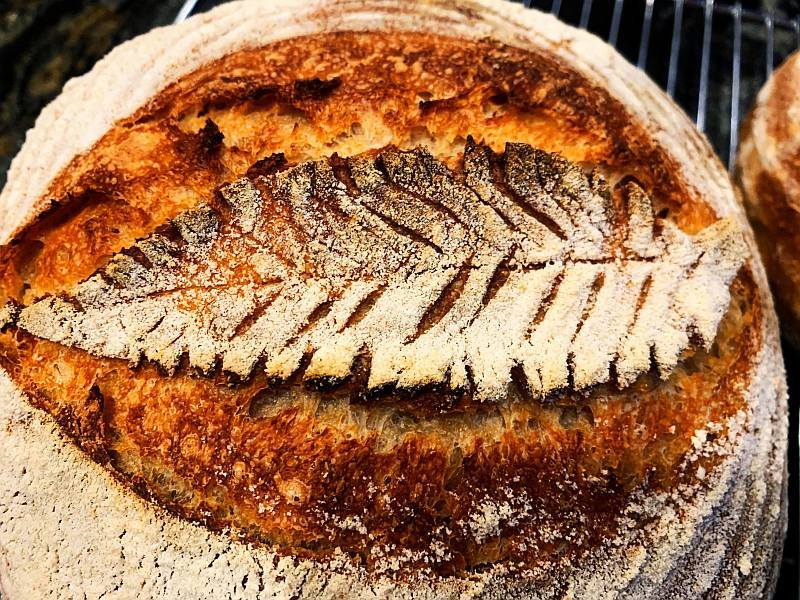
Responses